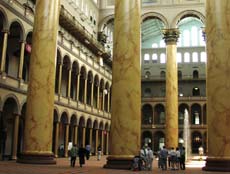index
Presenting systemic forms
click on images for full-size:



Columns presented as holding up the roof of the National Building Museum in D.C.

City government presented as a cathedral of power (Tokyo City Hall)
Architects often want to present aspects of a building's operative form. The modern movement wanted the building to present honestly its operations of resisting gravity, letting in light, circulating air, and so on. My point is that presenting the operative form of a building puts that form into a new context where it is contrasted not just with other possible operative forms (other ways of heating or other ways the ducts could have been mounted), but with other possible aesthetic effects, other strategies of presentation -- what was a matter of causal links and efficiency takes on questions of meaningful norms and aesthetic contrasts. The interplay of those issues makes the architect's task more challenging. Just as the operative form of a building will take on meaning when architects locate it within aesthetic and normative considerations, so large-scale systematic effects can be given normative or grammatical places. For instance, environmental effects have become normatively important in ways that they were not before. Also, there can be places that ritualize systemic functions -- stock exchanges, financier's clubs -- though there still remains a difference between the system interactions and the grammar of those places, as we see when such institutions continue on even though systemic patterns have altered. There are also normative social roles that are dedicated to the use and control of systemic effects. Another mixture occurs when a system effect changes the local horizon of meaning. For instance, when a corporation in search of profit brings in images and symbols from outside, say, by satellite TV reaching into remote areas, this puts local norms into new meaning contrasts.